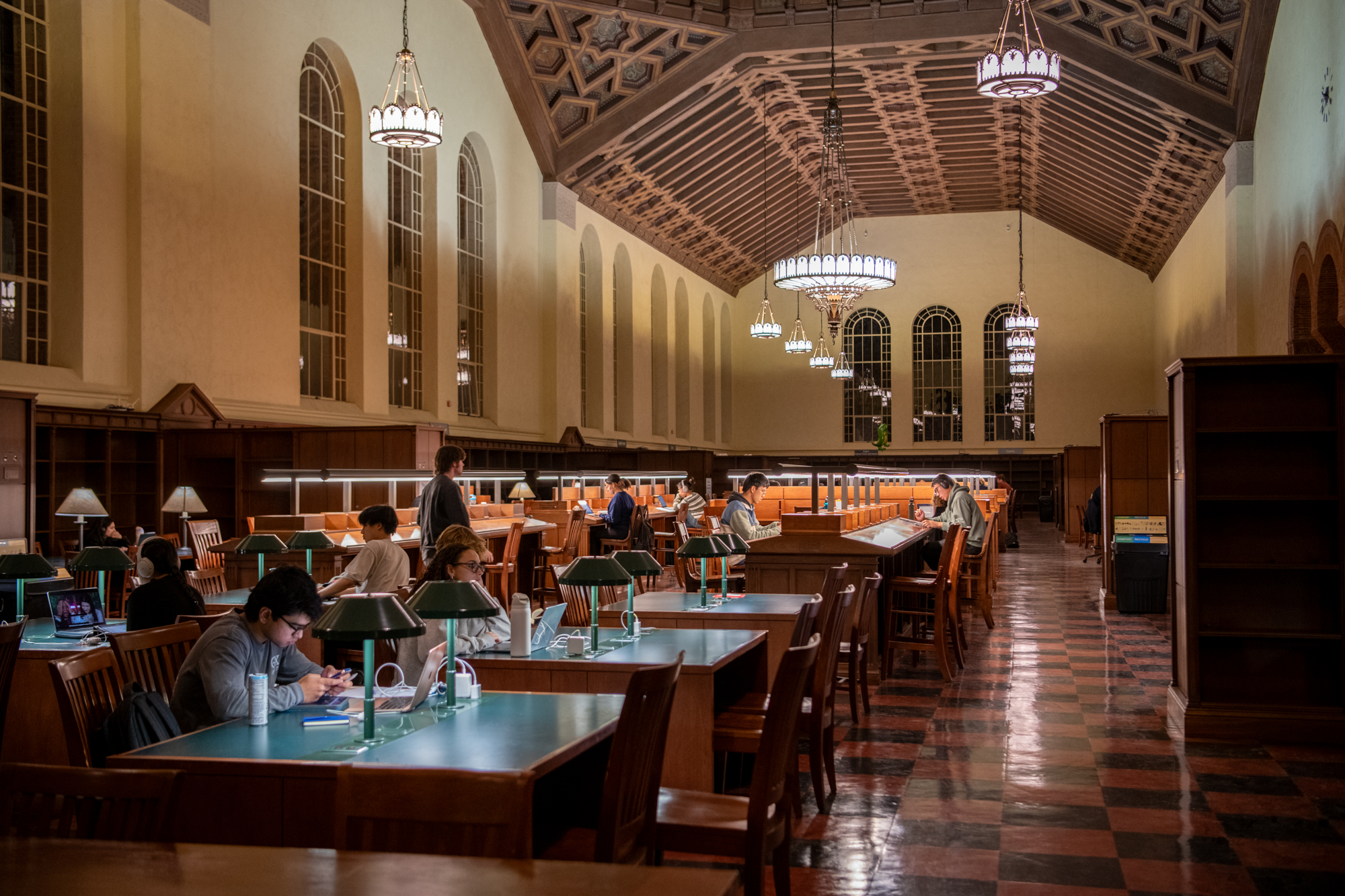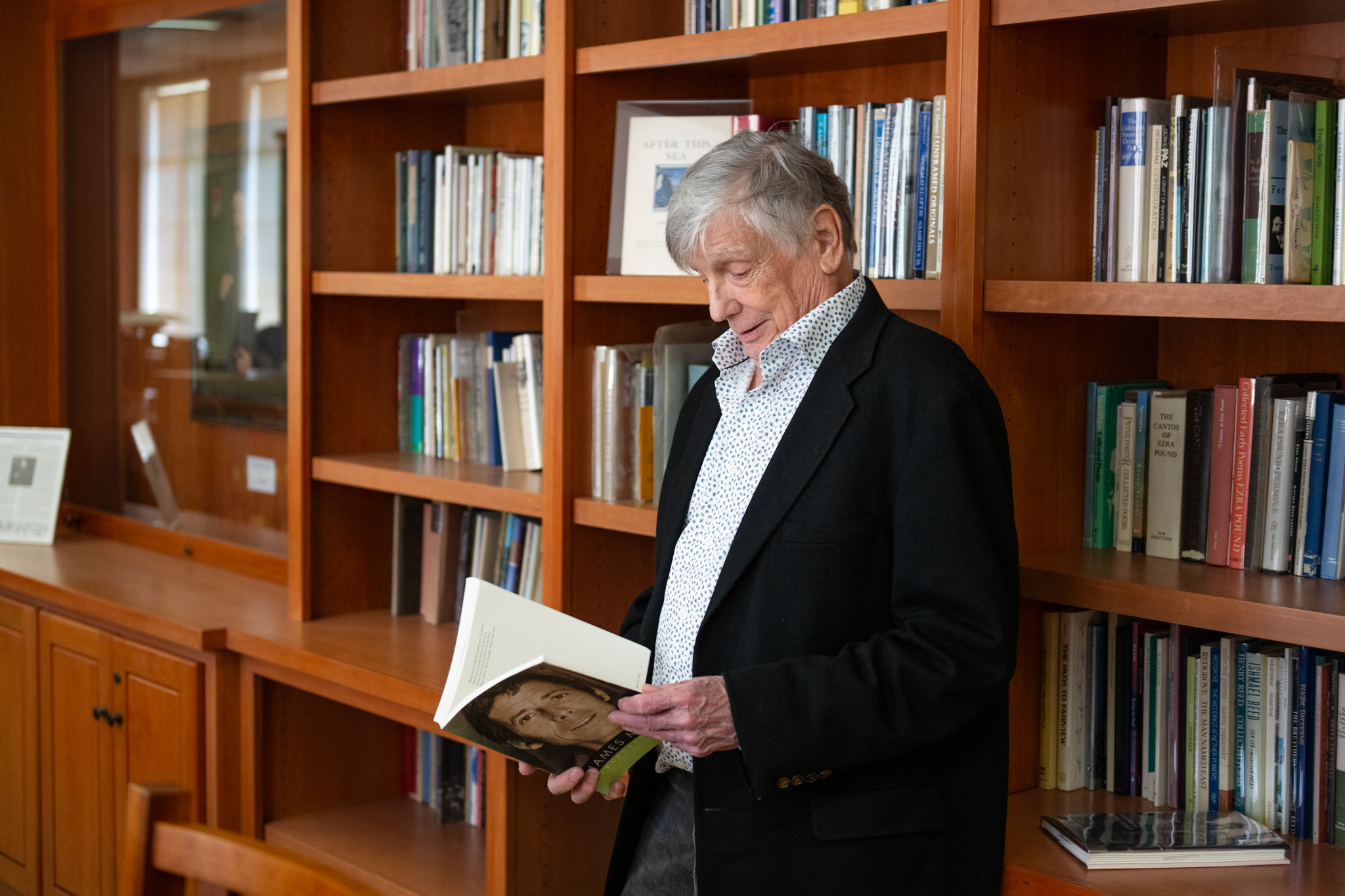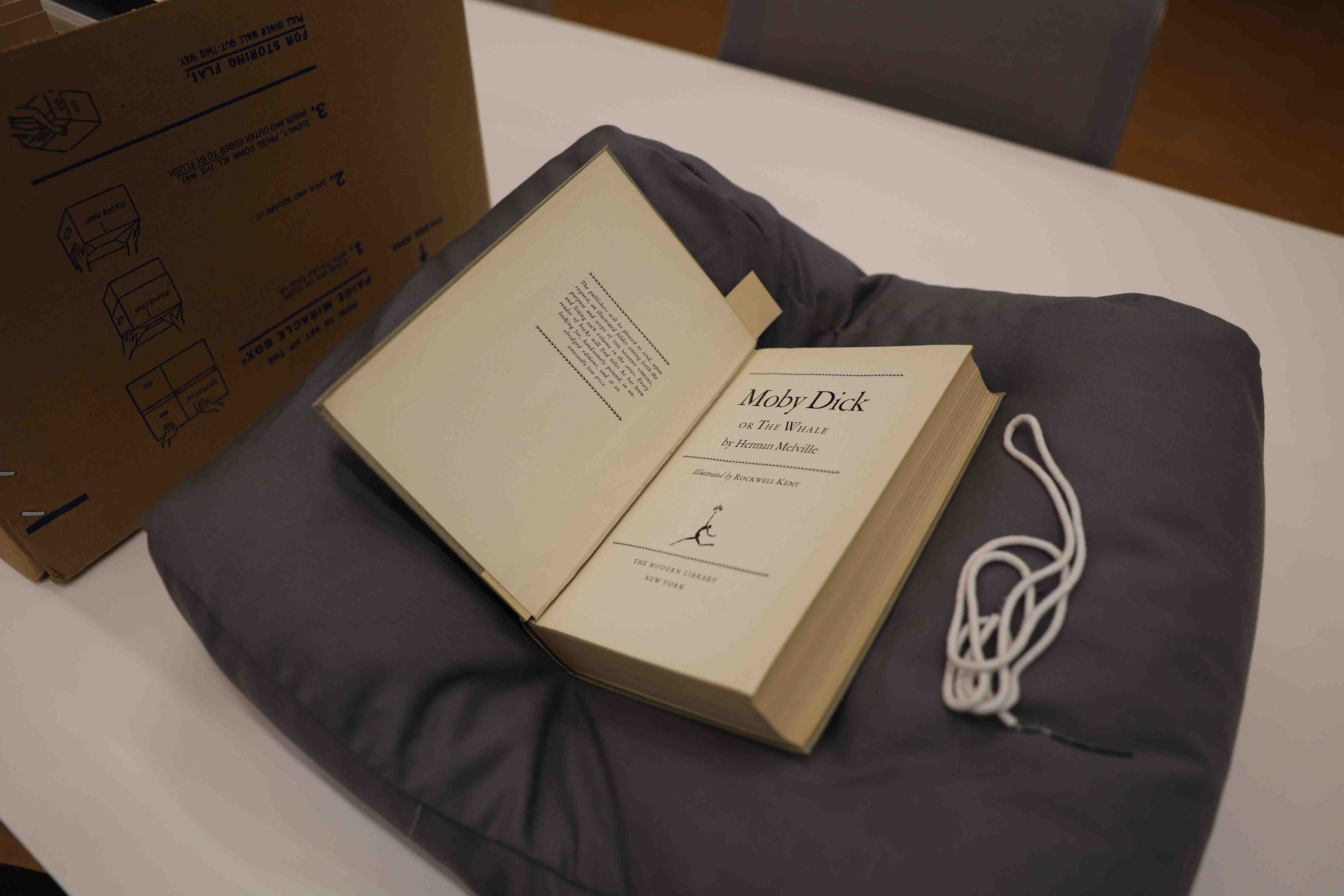(Photo by Andrew Diaz/Daily Bruin. Illustration by Sophia Kim/Daily Bruin)
By Andrew Wang
March 15, 2025 at 9:58 p.m.
Above and beyond publishing journal articles, credentialing young people and producing spectacles on the court, the field and the gridiron, the job of a university is to keep the books.
Less visible than some of the university’s more prominent architectural symbols, the Michael Sadleir Collection of Nineteenth-Century British Fiction is deeply tied to the history, and the purpose, of UCLA. The whole organism of the university is seen in action around the collection: Administrators allocate budgets for expansion and acquisitions, archivists preserve the physical copies of novels, researchers produce new knowledge based on the contents of the collection, and instructors communicate that knowledge to a new generation of students.
In 1948, university librarian Lawrence Clark Powell purchased 1,925 volumes of minor Victorian novelists on the recommendation of Bradford Booth, the then-chairman of the English department.
“He (Powell) was interested in advancing our status as a relatively newer institution, as compared to the Ivies,” said Courtney Jacobs, head of public services, outreach and community engagement at UCLA Library Special Collections. “They had significant holdings in their collection that made them unique and desirable for certain areas of research, and Lawrence Clark Powell was looking for a way to put us on the map.”
Powell’s acquisitions were only the beginning of UCLA’s famous Victorian collection, and a significant advancement soon followed. In 1950, Michael Sadleir, an English literary historian and self-described “bibliomaniac,” was selling his valuable collection of British novels to fund business ventures after the financially disruptive WWII. Initially reluctant to pay the $65,000 asking price, the UC Board of Regents eventually approved the acquisition after serious interest from a competitor – the English department of the University of Illinois at Urbana-Champaign. Adjusted for inflation, the original $65,000 would be worth around $850,000 today.
The purchase was finalized in December 1951. Forty-three separate boxes containing almost 2,000 volumes arrived four months later. It took another year for everything to be moved, unpacked, examined and shelved at the College Library. The collection would later be moved one last time to a specially built room in the University Research Library, now called the Young Research Library.
Before UCLA attained R1 status, indicative of the highest research merit, the university had sought to acquire diverse texts – not only to boost intellectual output but to elevate its standing among institutional peers. The collection has since produced dissertations and academic conferences and served as a teaching aid for undergraduate and graduate courses alike. Buying the collection would, in Powell’s words, “make UCLA one of the great USA centers for research in this field.”
Today, the Michael Sadleir Collection is firmly integrated into the UCLA library system, the second largest collection by titles held in the nation. Preserving the works of both celebrated and forgotten writers, the collection serves as an intellectual hub for researchers, literature enthusiasts and wandering undergraduates alike – offering a window into the literary tastes and ambitions of Victorian novelists. In fact, anyone can request to see its materials – with supervision – at Library Special Collections.

The books themselves are kept in a well-lit and humidity-controlled room at the A level, one floor below the entrance of the Young Research Library. A single wooden door leads into a tall room dominated by floor-to-ceiling bookshelves. Rows of display lights hang from the ceiling like CCTV cameras, their concentrated beams illuminating rows and rows of book spines behind glass panes. There are few paperbacks in this room. Nearly every item is bound with leather and cloth of green, black, chestnut brown or mahogany.
A request must be made to see an item. Once the reader arrives, a staff member retrieves the material from its corresponding bookshelf. The collection is ordered with the Library of Congress system alongside Sadleir’s original single numerical system – he counted them, beginning at “1.” Hardcover volumes are stored with protective sleeves of plastic and must be examined not on a lectern but on a reading cradle, a specialized cushion for easily damaged books. Gloves are not required.
Sadleir’s collection, broadly speaking, contains many novels in the realist tradition – fiction that mimics the language and rhythms of daily life, whose plots are plausible and settings recognizable. According to Megan Stephan, a continuing lecturer in the English department, the goal of these novels was to depict the entire social environment as accurately as possible. While many of the canonical writers were of higher class, their works represented various characters from a spectrum of socioeconomic backgrounds.
The novelists writing these stories also emphasized the inner lives of their characters and their interrelations. In one of Charles Dickens’ better-known novels, a young woman interacts with a stranger whom the novelist delays in revealing as her biological mother for hundreds of pages.
“Those authors believed … that reading novels actually made you a better person, because it enabled you to have empathy for people whose lives were not exactly like yours,” Stephan said.
Those same writers also hoped their popular appeal would energize the public into social reforms. A variety of true-to-life characters exposed readers to a diverse society they would not otherwise be able to meet.
Stephan became an expert in Marie Corelli, a forgotten novelist of the occult and the pen name of English writer Mary Mackay, for her dissertation work. Stephan was interested not only in the writers whose work was considered of the highest caliber, those whose fictions have been validated by scholarship, but also in the pulpy and popular. Gaining an insight into the broad reading palette of past readers is also insight into the lives of people not exactly like our own – a kind of sociology of literature.
Not all of the thousands of books are entertaining or instructive. Only a fraction will make it to readers outside the English department in the form of “classics.”
”He (Sadleir) was very interested in representing women writers who we don’t necessarily talk about anymore,” Stephan said. “They’re not household names anymore – we don’t come across them in the same way. But they were household names during the time period when the books were published.”
This fading recognition, Stephan noted, underscores the need for a sustained readership to ensure a novelist’s works endure. Some of these writers were so forgotten by the 21st century that no popular bibliographies existed of them except within the Sadleir collection. In fact, important works are frequently neglected during their own time. For books like these, rediscovery depends on motivated collectors and motivated scholars. The collection even has such a novel, one “Moby-Dick.” A household name now, the work was virtually forgotten between the author’s death and its revival by literary scholars in the 1920s.
Before then, it stood, perhaps like other obscure classics soon to be rediscovered, in collections like Michael Sadleir’s.
“He had a huge capacity for thinking about books that people thought were ephemera or garbage at the time, and he saved us that history of those books,” said Jonathan Grossman, a professor in the English department.
Usually, acquired research items are simply absorbed into a greater archive, and many are simply inaccessible without special permission, or do not have standalone exhibition rooms. But as Grossman explained, the Sadleir collection has the uncommon privilege of being stored together in one room – mostly. A set of Sadleir’s Gothic novels was bought by another collector and is now owned by the University of Virginia.
Besides its main appeal – the novels of 19th-century writers – the collection room has other interesting memorabilia. On the side of each bookshelf hang Vanity Fair cartoons of famed writers – color-pencil drawings of bearded, bespectacled men with too-large heads and too-thin bodies. Arranged artfully throughout are dark, elegant tables and chairs from mid-century America. One wooden chair even transforms, ingeniously, into a stepping stool.
Jacobs said most of the furniture, including the bookshelves, was donated by Booth. The chairman knew Sadleir through their shared editorship in the academic journal Nineteenth Century Fiction. The acquaintanceship influenced Sadleir’s decision to sell his collection to UCLA.
“Part of the joy of it for him (Sadleir) was to find these things that weren’t always easy to find,” Stephan said. “He was interested in the condition of the books. He really wanted the most special, the fanciest looking.”
Described by Powell in a letter as “unassuming, witty, urbane, and of course, bookish,” Sadleir began his eclectic journey of collection at age 18. It began with his undergraduate textbooks, soon expanding – first to the poetry of French avant-gardists, then to London press pamphlets and periodicals, followed by Gothic romances. He collected Silver Fork novels, fiction about the English aristocracy and yellow-backs, cheap, short, sensational stories. By the time of the sale, Sadleir’s collection counted 8,625 rare books in total.
“Predominantly, he was a bibliographer, … somebody who’s interested in amassing an intellectual understanding of all the things that were published around a specific time period,” Jacobs said.
In his autobiography, Sadleir writes, “As my interest in moderns began to wane, I became possessed by childish memories.” Turning to the novels of his childhood, he began collecting the authors who populated his childhood home – Jane Austen, Charles Dickens, Anthony Trollope.
Material composition-wise, little has changed about novels. We are still using paper; we are still using ink. But while most commercial fiction flies off the printing press today as a single volume, many 19th-century novels were published in three separate parts, Jacobs said. That’s why catalogs of this period frequently distinguish between “titles” and “volumes.”
“The explosion (of publications) after steam printing and paper making and automated typesetting, which is the 1880s – when all that happens, it’s just so much more print,” Grossman said. “I mean, this is really their cell phones, right? This is what they’re looking at.”
Despite the prevalence of print, the costs of its paper and technology were still high. For avid readers of the 19th century, books were not easy to afford.
“It’s fully half of a week’s wage of your standard middle class person in Victorian England, and it would have been an entire monthly wage for … the working class. So you start to get these private libraries – not libraries like you think of today,” Jacobs said.
As it turns out, the public library is a recent invention. Michael Sadleir didn’t just preserve the books of the 19th century, he also preserved the Victorian model for how books – the durable, expensive editions capable of repeat reading – were circulated among wealthier readers. A private collector, after amassing a useful number of volumes, could lease their books for a subscription fee.
Such collections were called circulating libraries, and the economics of lending encouraged multi-volume novels.
“If you’re a private library and you have this huge collection of books, you can charge somebody more money to loan the first volume while you’re loaning the second volume to somebody else, while somebody else has the third volume,” Jacobs said.
It still works much in the same way – the lending part, not the paying part. Under the stewardship of UCLA, the Sadleir Collection, once the passion and profession of one man, has been preserved as a source of knowledge and intellectual community. As long as the inquisitive visitor has a UCLA catalog account, anything in the collection may be called up.
“I always want to be able to show 21st-century students, physically, practically, what does it mean that the 19th century had a thriving print culture?” Stephan said. “A collection like the Sadleir is a way to point to that and say, ‘See here.’”




